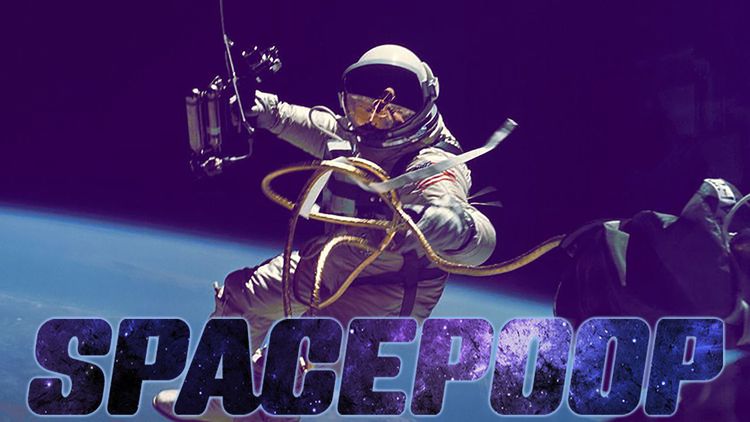New 'Space Poop' System Could Fly on Orion Deep-Space Mission

A new spacesuit system to flush away astronauts' poop will likely fly on the first crewed Orion spacecraft flight, NASA said in an interview with Space.com.
This means that eager innovators could see their waste collection system fly in space between 2021 and 2023 on "Exploration Mission 2," or EM-2, which could bring the astronauts out of low-Earth orbit for the first time in half a century.
NASA recently wrapped up an open "space poop challenge" for designs that improve upon the current spacesuit waste collection garment (sometimes referred to as a diaper). Winners will be announced Feb. 16. [How to Pee in Space (and What to Do If the Toilet Breaks)]
Winning designs will be able to flush away poop, urine and menstrual fluid for up to six days without the astronaut needing to use his or her hands. The substances have to be moved away in microgravity (where everything floats, even the gross stuff). Not only that, the new system has to have a design that works for any gender.
"The final waste management garment that is created won't be used nominally, but only in certain emergency situations that require spending long durations in a pressurized suit," Kristyn Johnson, one of the principal investigators for the study, told Space.com in an email. "For shorter durations, during launch and entry, the crew will plan to use an adult diaper as it fits our needs and is something we've used in the past."
NASA currently uses the Extravehicular Mobility Unit (EMU) for spacewalks on the International Space Station. This spacesuit type was first used in 1981 for the space shuttle program and, among other things, includes a diaper-like waste collection garment so that both males and females can relieve themselves while still inside. The EMU is designed for microgravity work, so NASA is also working on spacesuits that would be better suited for work on the surface of Mars.
"No major design changes have been made to the EMU waste collection garment over the years, as it still fulfils all the necessary requirements," Johnson said.
Get the Space.com Newsletter
Breaking space news, the latest updates on rocket launches, skywatching events and more!
"We're looking for a solution that will be included on the vehicle for upcoming manned Orion missions," she added. "EM-2 will be the first flight of a long duration waste management device. There is a possibility that it could be a part of a future Mars trip timeline, but we're not focused on that aspect right now."
Astronaut isolation?
While NASA says isolating sick astronauts isn't part of the space poop challenge, Smithsonian National Air and Space Museum curator Cathy Lewis pointed out the new waste collection system could be good for that, too.
During the Gemini program of the 1960s, which tested out key technologies used for the Apollo moon landings between 1969 and 1972, there was a project to determine how to treat astronauts who become ill while wearing spacesuits. This included using an "injection patch" in some of the Gemini suit types for astronauts to receive medications by needle without opening the suit, she told Space.com. [Evolution of the Spacesuit in Pictures (Space Tech Gallery)]
"Going from the injection patch to long term waste recovery is the next step," Lewis said. She added that the Apollo spacesuits had a built-in urine collection device that was hands-free, but it wouldn't work today as the system was designed only for male anatomy. (The first American female astronaut, Sally Ride, flew in space during the shuttle program in 1983.)
"The other limitation," she added, "is they are breathing pure oxygen, so they can't live in a spacesuit longer than 14 days. It's an absolute physiological maximum."
Lewis pointed out that bowel movements in space tend to be messy, even when not wearing a spacesuit. Astronauts are on a constant "low-producing" diet to keep poop to a minimum. Up until the end of the Apollo program, they dealt with feces using a plastic bag that attached to their rear ends. The bags were then stowed for the remainder of the mission.
On the space station today, however, astronauts don't need to go through that process; they instead use suction-operated toilets that don't require gravity to function.
Johnson said that after the contest's winners are announced, there will be a lengthy suit system design review where the agency tests and develops different options, then makes a final decision about which system to fly. As usual, NASA is also hoping to apply some of the technology to earthbound endeavors.
"We're happy to see all of the interest in this challenge," Johnson said. The challenge has been covered in more than 150 media outlets worldwide, according to the challenge website.
"It does have a lot of applicability to patients that may be on extended bed rest or those having to deal with incontinence," she added. "Being able to prevent skin breakdown, reduce odor, and fecal matter containment are just aspects of the challenge that we'd love to get input on. We're more than excited to hear people's concepts."
Follow Elizabeth Howell @howellspace, or Space.com @Spacedotcom. We're also on Facebook and Google+. Original article on Space.com.
Join our Space Forums to keep talking space on the latest missions, night sky and more! And if you have a news tip, correction or comment, let us know at: community@space.com.

Elizabeth Howell (she/her), Ph.D., was a staff writer in the spaceflight channel between 2022 and 2024 specializing in Canadian space news. She was contributing writer for Space.com for 10 years from 2012 to 2024. Elizabeth's reporting includes multiple exclusives with the White House, leading world coverage about a lost-and-found space tomato on the International Space Station, witnessing five human spaceflight launches on two continents, flying parabolic, working inside a spacesuit, and participating in a simulated Mars mission. Her latest book, "Why Am I Taller?" (ECW Press, 2022) is co-written with astronaut Dave Williams.









